Jeremiah sent in a fascinating post by Nicola at edible geography about how Prohibition, which outlawed liquor in the U.S. from 1920-1933, changed our culture in a number of ways that aren’t immediately apparent. Nicola draws heavily on historian David Okrent’s book Last Call.
An image from Detroit the day before Prohibition went into effect in 1920:
Although Prohibition made liquor illegal, there were a number of loopholes, including certain alcoholic “fruit juices” (which in effect meant wine and hard ciders were often allowed), medicinal uses of alcohol, and industrial alcohols. Nicola provides an image of a prescription booklet for medicinal alcohol:
These loopholes led to a dramatic rise in the popularity of wine in the U.S.: “American wine consumption increased from 70 million gallons in 1917 to 150 million gallons in 1925,” according to Nicola. That change affected the agriculture of California, in particular, where many acres of other crops were replaced with wine grapes. In another unexpected consequence, Okrent argues that the medicinal use loophole was a central factor in the success of drugstores such as Walgreen’s, since sales of alcohol for medical purposes were very profitable.
Prohibition also affected international maritime laws. At that time nations controlled the areas up to three miles off their shores. Along much of the U.S. coast, “Rum Rows” emerged, strings of generally foreign-owned ships anchored just outside the 3-mile jurisdiction limit, all full of liquor. They would openly advertise prices. This is an image of the Kirk and Sweeney loaded with illegal alcohol in 1924 (via):
The U.S. Coast Guard has a collection of images of its efforts to stop the illegal importation of liquor. This image shows one of the small rum runner boats that would sail from the shore to Rum Row to load up on alcohol, as it approaches a British-owned boat called the Katherine in 1923:
Nicola describes the scene:
…a floating ship-city, thousands of miles in length, bobbing up and down in place along the coast of America, and serviced by a fleet of much smaller, nimble rum runners that slipped to and from the mainland under cover of night.
The U.S. government began to push for an extension of the area of the ocean over which governments have jurisdiction, from 3 miles to 12, which would make it much more difficult, time-consuming, and dangerous to run liquor in from the larger ships. The U.S. eventually succeeded in pushing its national borders outward, expanding national sovereignty over oceans, another unexpected consequence of our anti-alcohol policies. Rum Row dutifully relocated farther offshore.
Apparently Prohibition also fueled the popularity of mixed drinks (the mixers helped mask the smell and often unpleasant taste of bootleg liquor) and dinner parties (since you couldn’t buy liquor openly at restaurants but were relatively safe serving it in your home). According to a set of Life photos about Prohibition, sales of Coca Cola tripled, since soda served as both a substitute and mixer for alcohol:
From the Life photoessay:
“People don’t realize,” Okrent told LIFE.com, “how much drinking there was in this country before Prohibition. We were awash in booze. In 1830, for example, the per capita consumption of alcohol was three times what it is today — 90 bottles of booze per year per person over the age of 15. By 1933, drinking was around 70 percent of pre-Prohibition levels, and with some fluctuations has stayed well below pre-Prohibition levels ever since.
Okrent says that contrary to what we often see in movies, where speakeasies are built to be easily dismantled or disguised as legal businesses in case the cops raided, by the late 1920s, many speakeasies were set up as permanent structures that were clearly serving liquor, and customers felt fairly secure going to them:
As soon as liquor became legal again, Americans enthusiastically returned to openly buying and selling it, though, as Okrent said, not at pre-Prohibition levels (photo from a different Life photoessay):
The Budweiser company decided to deliver beer to several high-profile locations by horse-drawn cart as a marketing stunt, giving us the iconic Budweiser Clydesdales. Here they are on their way to the Empire State Building:
And if you buy Okert’s argument, Prohibition even gave us NASCAR; he says it emerged in the South after Prohibition ended, when all the former runners of liquor needed new uses for their driving skills and fast cars now that they could no longer make a profit smuggling booze.
So there you have it: some of the unintended consequences of Prohibition, and example of the way public policy can have implications for areas of social life that seem far removed from the topic at hand.

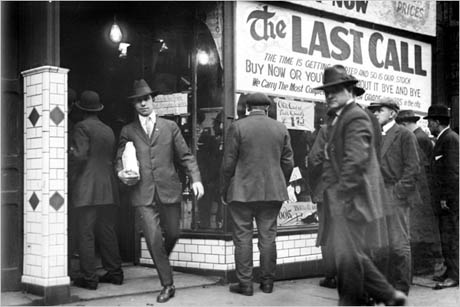

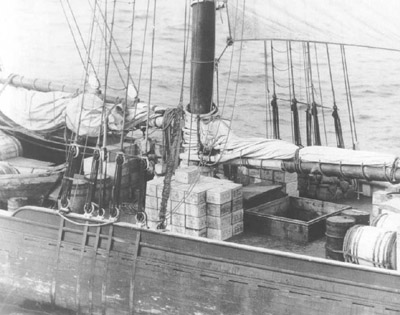
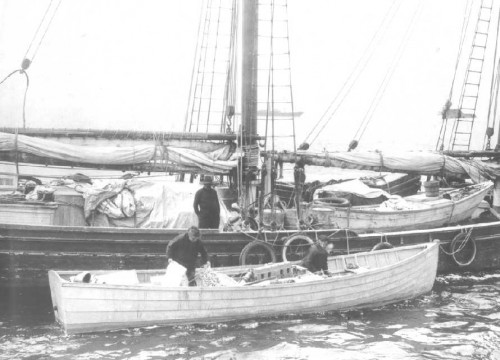
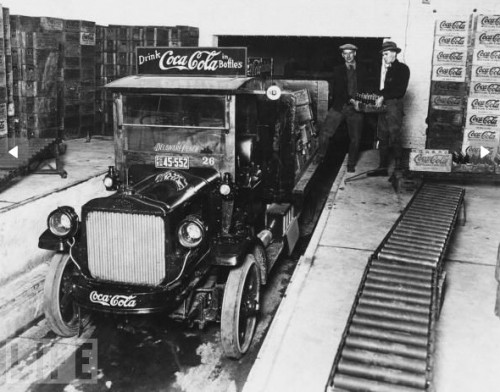
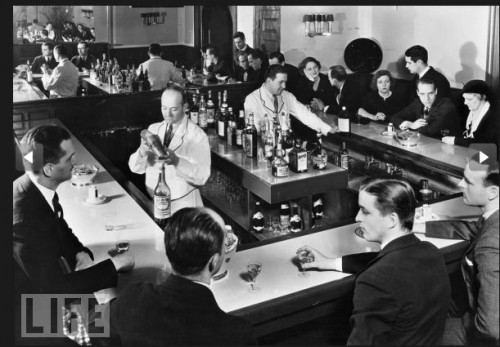

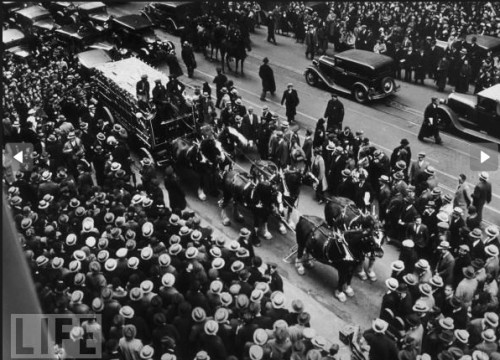
Comments 37
Michael Patrick — October 10, 2010
Very interesting, I enjoyed your writing and hope you produce more! May I use this in one of the English classes that I teach? Your fiend, Mike
jfruh — October 10, 2010
This actually ties in a bit w/your previous post -- the newspaper article stating that areas that were more dependent on the alcohol trade were more likely to be anti-women's suffrage. Prohibition was very much a female-driven movement, and much of the justification for it was framed in terms of domestic abuse: men were deemed to be much more likely to beat their wives when they were drunk.
ricecake — October 10, 2010
Fascinating, thank you! My grandfather once told me how he would buy barrels of juice that had on the side a paper that followed the letter of the law, but not the spirit, something along the lines of:
"100% grape juice. It is illegal to add three a half-pound of sugar and a knob of yeast to this juice. It is illegal to cork it and let it ferment for for two weeks..." -and so on.
Bagelsan — October 10, 2010
I'm really interested that overall alcohol consumption went (and stayed) down, at least somewhat. Would that mean that Prohibition "worked" a tiny bit?
larrycwilson — October 10, 2010
Another contribution of Prohibition was providing enough income to organized crime that it developed into Big Crime. When Prohibition ended this money was invested in many other activities, some of them legal and some of them not.
Christine — October 10, 2010
Don't forget how Prohibition directly affected places other than the US -- it was because of Prohibition that the Canadian government stepped in to regulate and control the production and sale of alcohol in Canada, since the profits from selling illegal booze to the US were so great that even the government decided that they wanted a piece! The Canadian government still controls the sale and distribution of alcohol in Canada today, and both the Ontario Control Board of Board and the BC Liquor Distribution Branch are two of the largest single purchasers of alcohol in the world.
Anonymous — October 10, 2010
I grew up in a house that was originally built as a speakeasy. It had two fireplaces, a long, open front room, a section of shelves that could be taken out of a wall, and the top half of the wall would swing open to reveal a bar...the kitchen had a pass through window to the 'bar' area, and the kitchen door was one of those that opens separately on the top and bottom...and the garage was built out of cinder blocks and cement with huge swinging wooden doors...and the edge of the roof was lined with small turrets!
Heina — October 11, 2010
That "prescription booklet for medicinal alcohol" reminds me of how medical marijuana works in states where it is legal: people trumping up "legitimate" reasons for wanting something that is pleasurable.
Re unknown consequences of laws on substances: I do know people who have recommendations (as the prescriptions for pot are called) for true medical reasons, but many of them get them via fabricated medical reasons so that they can smoke and obtain pot legally, since most dealers in California have either gone legal or gone out of business thanks to the proliferation of dispensaries. Now that street weed is almost an anachronism in California, many of the dispensaries oppose Prop 19, the proposition that would legalize pot for all, because it would lead to more competition.
Lisa — October 11, 2010
Billy Ray Cyrus narrates a history of Prohibition and NASCAR in the Appalachians. I don't know if I saw it on the History channel or PBS, but it was interesting.
Scott M. — October 11, 2010
Prohibition killed off the hundreds of small, local breweries that florished in the early 20th century. Larger outfits, like Budweiser, were able to survive by selling "near-beer", and after prohibition ended, they moved in quickly to replace the local producers. 50 years would pass before the microbrew revolution would bring back local, fresh, flavorful beer to America.
Matthew Yglesias » Last Call — October 11, 2010
[...] to write a full review, but I don’t really have time, so instead I’ll offer a link to this post which extracts a lot of the most interesting [...]
Annebonanie — October 11, 2010
No mention of the Mafia?
A. Helin — October 11, 2010
This is a good occasion to link to this article: http://www.slate.com/id/2245188/
"The little-told story of how the U.S. government poisoned alcohol during Prohibition with deadly consequences". Essentially, the US government added poisonous substances to industrial alcohol, knowing it would finds its way to the lips of the disadvantaged and poor. They knew this would happen, and that people would keep drinking it; alcoholism is a physical condition. You essentially had the government systematically poisoning the undesireables of society, with nary a word spoken.
Rajeev — October 12, 2010
Excellent!
jamy — October 12, 2010
The other legal use of alcohol was for religious purposes, which probably accounts for some of the California wine-growing.
D Lucas — October 12, 2010
RE: Religious use of alcohol being legal- My husband's grandfather's father deserted the family. The mother had 2 children to support. The rabbi in the Mass town where they lived gave her the "legal OK" to produce wine for their synagogue- knowing that she would also then bootleg it & be able to support her family.
links for 2010-10-13 « Embololalia — October 13, 2010
[...] Unintended Consequences of Prohibition » Sociological Images “People don’t realize,” Okrent told LIFE.com, “how much drinking there was in this country before Prohibition. We were awash in booze. In 1830, for example, the per capita consumption of alcohol was three times what it is today — 90 bottles of booze per year per person over the age of 15. By 1933, drinking was around 70 percent of pre-Prohibition levels, and with some fluctuations has stayed well below pre-Prohibition levels ever since. (tags: alcohol history usa us.constitution social.policy police) [...]
Morning Constitutional – Thursday, 14 October 2010 - Verities and Vagaries — October 14, 2010
[...] The unintended consequences of alcohol prohibition. Included: NASCAR. [...]
TV — October 14, 2010
I hate to nitpick, but the author of "Last Call" is DANIEL Okrent, not David.
Steve T. — October 14, 2010
Here's another unintended consequence, according to George Chaunce's "Gay New York: Gender, Urban Culture, and the Making of the Gay Male World, 1890-1940." (Terrific book.) In the 1920s, during Prohibition, there was a huge upsurge in New York's gay subculture, and it was a pretty easy place to live if you were gay. A lot of straight people thought it rather daring and wicked to have openly gay friends, and there were some flamboyantly queeny nightclub stars who were wildly popular with straight audiences, largely for the titillation factor of course.
With Repeal coming, the anti-liquor forces were in retreat, but still powerful enough to make demands. One was that places that served alcohol could be fined or closed if they didn't see that their patrons were "of good character." One of the things that meant was, not homosexual. Many bars and restaurants, even cafeterias popular with gays, were harassed in the name of that phrase. And with the Depression and hard times coming, what many saw as the self-indulgence of the homo was frowned upon, and the culture became more straight laced. So to speak.
Result: The gay subculture was driven underground, there to stay for decades. The Mob turned some of their speakeasies into gay bars, charging absurd prices for drinks and paying off cops to prevent raids. This didn't always work, as cops would stage raids anyway just to keep gays terrorized and in their place. This was effective, as a man caught up in a gay bar raid could lose everything: family, home, job, a future.
But being underground changed gay culture, too, as generations of gays and lesbians learned how to live while hiding in plain sight. Many still do, unless they get caught. ("Oh, Senator Craig, call from Reverend Haggard on line one.") And the simmering anger at being unfairly oppressed led to the birth of the gay rights movement and modern gay culture. Camp, cruising techniques, code words, gaydar, drag queens, Fire Island, White Parties, Will & Grace, Brokeback Mountain ... ahh, my people, what we have built together. All these are products of modern gay culture and thus indirect results of the "of good character" clause. And they certainly were not what the anti-liquor guardians of moral rectitude intended.
Jay Livingston — October 14, 2010
"We were awash in booze. In 1830, for example, the per capita consumption of alcohol was three times what it is today." True, and that probably was because most water was not potable. I think Okrent (Daniel, by the way, not David) is cherry picking his dates and that consumption dropped steeply after 1830 or so.
@bagelsan. Prohibition did reduce alcohol consumption. Hospital admissions for alcohol related things went down.
Mike Rose — October 14, 2010
"Nicola draws heavily on historian David Okrent’s book Last Call."
As several other commenters have noted, this has been incorrect now for four days. DANIEL Okrent is the author of Last Call, as well as the former public editor of The New York Times and managing editor of LIFE Magazine (where I had the pleasure of working for him, briefly).
Friday Linkfest « Blank Page Filled — October 15, 2010
[...] Unintended Consequences of Prohibition Apparently Prohibition also fueled the popularity of mixed drinks (the mixers helped mask the smell and often unpleasant taste of bootleg liquor) and dinner parties (since you couldn’t buy liquor openly at restaurants but were relatively safe serving it in your home). According to a set of Life photos about Prohibition, sales of Coca Cola tripled, since soda served as both a substitute and mixer for alcohol. Possibly related posts: (automatically generated)22 de Enero: ‘Blog’ por el derecho a decidir [...]
Nascar and Prohibition | Free Market Mojo — October 16, 2010
[...] Sharp cites historian Daniel Okrent: [Daniel Okrent] says it emerged in the South after Prohibition ended, when all the former runners [...]
xiami 2 — August 22, 2011
http://zhengyi101.wordpress.com
Hawaii raised its smoking age because people who were already too young to smoke are smoking | Rare — July 27, 2015
[…] unintended consequences of Prohibition were many and are well-documented—and the unintended consequences of the drug war are beginning to receive similar […]
La Storia del Proibizionismo in America #LegaNerd — September 19, 2016
[…] Unintended consequences of Prohibition (thesocietypages.org) […]
Democrat Busybodies and the Destruction of Freedom | Metallicman — May 17, 2018
[…] Extension of US Naval territorial waters. The U.S. government began to push for an extension of the area of the ocean over which governments have jurisdiction, from 3 miles to 12, which would make it much more difficult, time-consuming, and dangerous to run liquor in from the larger ships. The U.S. eventually succeeded in pushing its national borders outward, expanding national sovereignty over oceans, another unexpected consequence of our anti-alcohol policies. […]
Karen Moon — August 13, 2022
Good work.